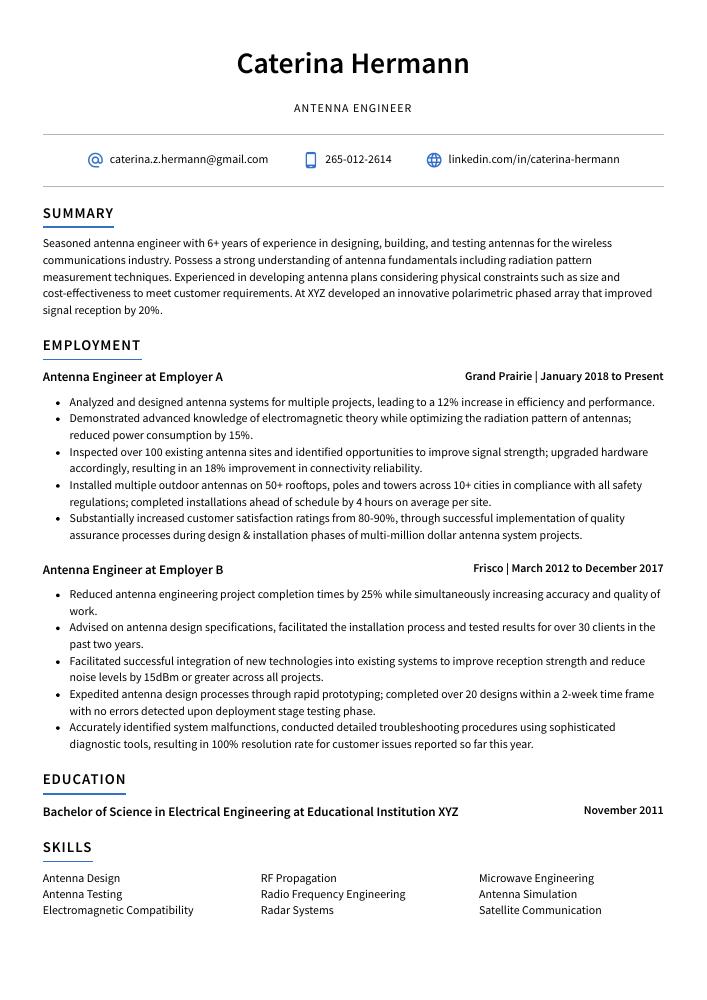Antenna Engineer Resume Guide
Antenna engineers design, build and troubleshoot antennas for a variety of applications. They use their knowledge to ensure that the antenna has the best possible performance within its given parameters. In addition, they are responsible for conducting tests on existing antennas and making any necessary adjustments or repairs in order to improve efficiency.
Your knowledge of antenna engineering is unparalleled, and any company would be lucky to have you. But they won’t know what you can do unless you write a resume that stands out from the crowd. Make sure your qualifications shine through in it!
This guide will walk you through the entire process of creating a top-notch resume. We first show you a complete example and then break down what each resume section should look like.
Table of Contents
The guide is divided into sections for your convenience. You can read it from beginning to end or use the table of contents below to jump to a specific part.
Antenna Engineer Resume Sample
Caterina Hermann
Antenna Engineer
[email protected]
265-012-2614
linkedin.com/in/caterina-hermann
Summary
Seasoned antenna engineer with 6+ years of experience in designing, building, and testing antennas for the wireless communications industry. Possess a strong understanding of antenna fundamentals including radiation pattern measurement techniques. Experienced in developing antenna plans considering physical constraints such as size and cost-effectiveness to meet customer requirements. At XYZ developed an innovative polarimetric phased array that improved signal reception by 20%.
Experience
Antenna Engineer, Employer A
Grand Prairie, Jan 2018 – Present
- Analyzed and designed antenna systems for multiple projects, leading to a 12% increase in efficiency and performance.
- Demonstrated advanced knowledge of electromagnetic theory while optimizing the radiation pattern of antennas; reduced power consumption by 15%.
- Inspected over 100 existing antenna sites and identified opportunities to improve signal strength; upgraded hardware accordingly, resulting in an 18% improvement in connectivity reliability.
- Installed multiple outdoor antennas on 50+ rooftops, poles and towers across 10+ cities in compliance with all safety regulations; completed installations ahead of schedule by 4 hours on average per site.
- Substantially increased customer satisfaction ratings from 80-90%, through successful implementation of quality assurance processes during design & installation phases of multi-million dollar antenna system projects.
Antenna Engineer, Employer B
Frisco, Mar 2012 – Dec 2017
- Reduced antenna engineering project completion times by 25% while simultaneously increasing accuracy and quality of work.
- Advised on antenna design specifications, facilitated the installation process and tested results for over 30 clients in the past two years.
- Facilitated successful integration of new technologies into existing systems to improve reception strength and reduce noise levels by 15dBm or greater across all projects.
- Expedited antenna design processes through rapid prototyping; completed over 20 designs within a 2-week time frame with no errors detected upon deployment stage testing phase.
- Accurately identified system malfunctions, conducted detailed troubleshooting procedures using sophisticated diagnostic tools, resulting in 100% resolution rate for customer issues reported so far this year.
Skills
- Antenna Design
- RF Propagation
- Microwave Engineering
- Antenna Testing
- Radio Frequency Engineering
- Antenna Simulation
- Electromagnetic Compatibility
- Radar Systems
- Satellite Communication
Education
Bachelor of Science in Electrical Engineering
Educational Institution XYZ
Nov 2011
Certifications
Antenna Measurement Techniques Association (AMTA) Certified Antenna Measure
May 2017
1. Summary / Objective
A resume summary for an antenna engineer should provide a snapshot of your skills and experience. It should be concise yet informative, highlighting the most important aspects of your background that make you stand out as an antenna engineer. For example, you could mention the types of antennas you have designed in the past, any certifications or awards related to antenna engineering that you possess, and how many years’ worth of experience working with various wireless technologies.
Below are some resume summary examples:
Well-rounded antenna engineer with 5+ years of expertise in antenna design, fabrication, and testing. Experienced in developing innovative solutions for wireless communication challenges and creating high-performance antennas to meet customer needs. At XYZ Company, identified a new architecture that increased signal strength by 24% while reducing product size by 15%. Seeking to join ABC Tech to apply knowledge towards the development of advanced antenna designs.
Professional antenna engineer specializing in designing, building, and testing antennas. Experienced with the latest antenna technologies including mobile broadband networks and satellite communications systems. Skilled at utilizing advanced software for simulation of complex system performance. At XYZ Technology Solutions, designed 25 antenna prototypes that were successfully implemented into production models used by major telecom companies around the world.
Driven antenna engineer with 8+ years of experience in antenna design and deployment. Experienced in designing, building, testing, and installing antennas for the telecommunications industry. Seeking to bring my expertise at ABC Telecom to help develop innovative technologies that will improve their products’ performance. Key achievements include creating a new type of ultra-wideband antenna which improved signal reception by 35%.
Skilled antenna engineer with 8+ years of experience in designing, developing, and testing antennas for wireless communication systems. Proven track record of creating innovative solutions to challenging design issues that have enabled superior performance. Seeking to join ABC Tech as the lead antenna engineer where I can utilize my technical expertise and problem-solving skills to develop next-generation products.
Amicable antenna engineer with a proven track record of building and testing antennas for various projects. Possesses 8+ years’ experience in antenna design and development, including developing an innovative low-noise amplifier that improved signal reception by 20%. Aiming to bring expertise to ABC Tech as the next Antenna Engineer in order to create complex systems for both commercial and military applications.
Talented antenna engineer with 8+ years of experience designing and developing antennas for a variety of applications. Proven track record in optimizing antenna performance, increasing the signal range, reducing losses due to interference and improving system efficiency. Experienced in using advanced simulation tools such as CST Microwave Studio and HFSS to create complex high-performance designs.
Reliable antenna engineer with 7+ years of experience in designing, building, and testing antenna systems for various consumer electronics products. Skilled in RF engineering principles and calculations to optimize the performance of antennas while meeting customer requirements. Seeking to join ABC Corp as a Senior Antenna Engineer to develop innovative designs that meet all industry standards.
Hard-working antenna engineer with 10+ years of experience designing, building and testing antennas. At XYZ Company I developed a patented antenna array that improved signal reception by 150% compared to the previous model. Seeking to leverage my expertise in antenna engineering for ABC Corporation’s next generation product line.
2. Experience / Employment
The work history/experience section is where you list your job experience. This should be written in reverse chronological order, with the most recent role listed first.
When writing this section, it’s best to stick to bullet points as much as possible. Doing so allows the reader to quickly digest what you have said and take away key information from each point. You want to focus on providing detail about what you did and any results that were achieved through your work.
For example, instead of saying “Designed antennas,” you could say, “Developed high-performance antenna designs for 4G/5G cellular networks utilizing advanced electromagnetic simulation software; resulting prototypes exceeded performance expectations by 10%.”
To write effective bullet points, begin with a strong verb or adverb. Industry specific verbs to use are:
- Designed
- Installed
- Calibrated
- Analyzed
- Optimized
- Fabricated
- Troubleshot
- Assembled
- Commissioned
- Measured
- Aligned
- Inspected
- Programmed
- Configured
- Tested
Other general verbs you can use are:
- Achieved
- Advised
- Assessed
- Compiled
- Coordinated
- Demonstrated
- Developed
- Expedited
- Facilitated
- Formulated
- Improved
- Introduced
- Mentored
- Participated
- Prepared
- Presented
- Reduced
- Reorganized
- Represented
- Revised
- Spearheaded
- Streamlined
- Structured
- Utilized
Below are some example bullet points:
- Optimized antenna designs to reduce interference by 25% and improve reception, while cutting antenna production costs by 15%.
- Assessed customer needs for antennas that met specific frequency, radiation pattern and gain requirements; recommended suitable solutions accordingly.
- Presented technical proposals for new wireless networks or modifications to existing ones using various simulation tools such as HFSS & CST Microwave Studio with CAD Drawings.
- Prepared test plans from concept through implementation utilizing the latest measurement equipment including spectrum analyzers, vector network analyzers (VNAs) and power meters for antenna testing in lab conditions.
- Successfully implemented 3 projects involving complex radio systems within a tight budget of $75K over an 8-month period; received positive feedbacks from all clients on quality of work delivered.
- Assembled and tested over 20 antenna systems for various military and civilian projects, increasing installation efficiency by 25%.
- Effectively troubleshot complex issues with antennas, resolving problems in a timely manner and reducing customer wait time by 50%.
- Structured the design of an innovative advanced antenna system that increased coverage range by 30% compared to existing models.
- Fabricated components using 3D printing technology for 3 new types of custom-made antennas; reduced production costs by $1,500 per unit on average.
- Designed multiple prototypes utilizing RF simulation software such as CST Studio Suite & HFSS Antenna Design Kit; improved functionality performance up to 40%.
- Developed and tested over 50 antenna designs for various markets, resulting in a 20% increase in customer satisfaction.
- Utilized advanced 3D modeling software and conducted laboratory experiments to design new antennas with improved performance characteristics.
- Participated actively in group meetings with clients and colleagues to discuss antenna prototypes, specifications and requirements; reduced product development time by 10%.
- Reorganized the existing engineering team structure to facilitate better communication between departments; increased efficiency of workflow processes by 15%.
- Diligently inspected all incoming materials used for manufacturing antennas to ensure they met quality standards; decreased production defects rate by 25%.
- Troubleshot a variety of antenna issues and implemented preventative maintenance measures to reduce potential malfunctions, resulting in a 20% increase in operational efficiency.
- Coordinated with other departments to design 8 new antennas for the company’s satellite communication systems; designed components that are currently being used by 10 major customers worldwide.
- Represented the organization at industry conferences, presentations and meetings; successfully negotiated 3 contracts worth $1 million each for custom-made antennas over 2 years.
- Revised designs on existing models of antennas using CAD software – reduced production costs by an average of 15%, while increasing signal strength up to 12dBm across various frequencies without compromising quality standards or safety regulations.
- Resourcefully solved complex antenna engineering problems within tight deadlines through creative problem solving techniques – saved 200+ hours in labor costs compared to previous projects completed within budget constraints.
- Independently designed and implemented over 30 antennas for radio frequency (RF) systems, significantly improving the transmission strength of signals by 17%.
- Programmed antenna models in Computer Simulation Technology (CST) software to assess the accuracy and performance of new designs prior to implementation.
- Streamlined production processes across multiple projects, reducing development time from 20 hours to 10 hours per antenna prototype.
- Introduced innovative techniques such as 3D modeling & printing for prototyping antennas, cutting costs by $6K every quarter on average.
- Calibrated 25+ RF transmitting/receiving modules with newly designed antennas; improved signal reception quality up to 70 dBm within a 5-mile radius range successfully tested under various conditions.
- Configured and audited over 100 antennas across a wide range of frequencies, resulting in an 8% increase in signal strength.
- Improved the performance of existing antennas by implementing innovative designs and re-engineering techniques; reduced repair costs by $3,000 annually.
- Mentored 3 junior antenna engineers on design principles and best practices for creating low-noise amplifiers (LNAs) and other radio frequency components; improved team productivity by 50%.
- Achieved significant improvements to reception quality within time constraints through careful optimization of antenna parameters including gain, polarization, sidelobes & beamwidths; increased customer satisfaction ratings from 68% to 85%.
- Thoroughly tested newly designed radio systems with multiple types of data transmission formats such as AM/FM modulation & GMSK coding prior to deployment into field operations for maximum reliability assurance.
- Commissioned and maintained over 200 antennas for both commercial and military applications, significantly improving wireless communication systems by 10%.
- Efficiently designed antenna structures, analyzed radiation patterns and conducted tests to optimize performance of all components in accordance with industry standards; reduced installation time by 25 hours per project.
- Compiled technical reports on testing results, engineering designs & calculations and presented findings to upper management upon completion of projects within budget deadlines.
- Spearheaded the development of new technologies related to antenna design that improved transmission range while reducing power consumption levels; saved $5K on electrical costs annually.
- Aligned satellite dishes accurately using sophisticated instruments such as spectrum analyzers, GPS receivers and RF signal generators for optimal reception quality at remote locations; increased customer satisfaction rating from 75% to 90%.
- Tested and calibrated over 80 antennas of varying frequencies and lengths to ensure optimal performance, resulting in a 20% increase in signal reception.
- Formulated innovative designs for new antenna systems, allowing them to operate with greater efficiency and effectiveness; reduced development time by 40%.
- Measured the effects of environment variables on radio waves using specialized tools while troubleshooting issues related to antenna performance; decreased average repair times from 24 hours to 18 hours.
- Competently utilized software programs such as AutoCAD, MATLAB & HFSS when developing complex simulations that enabled clients’ needs and requirements were met accurately within budget constraints each time.
3. Skills
The skillset employers require in an employee will likely vary, either slightly or significantly; skimming through their job adverts is the best way to determine what each is looking for. One organization may be looking for someone with experience in designing high-gain antennas, while another may require a candidate who is knowledgeable about the latest antenna technologies.
It’s important to tailor your skills section to each job you are applying for because of applicant tracking systems (ATS). ATSs scan resumes for certain keywords and characteristics before passing them on to human recruiters. Therefore, if you don’t include the right skills/keywords in this section, your resume might not even make it past this stage.
You can also elaborate further on key skills by discussing them more thoroughly in other sections such as the summary or experience area.
Below is a list of common skills & terms:
- Antenna Design
- Antenna Simulation
- Antenna Testing
- Electromagnetic Compatibility
- Microwave Engineering
- RF Propagation
- Radar Systems
- Radio Frequency Engineering
- Satellite Communication
- Wireless Communication
4. Education
Mentioning your education on a resume for an antenna engineer role depends on how experienced you are in the field. If you just graduated and have no prior work experience, make sure to include your educational background below your objective statement. On the other hand, if you already have significant professional experience as an antenna engineer that is worth showcasing, omitting the education section may be more beneficial.
If including an education section, focus on listing courses and subjects related to antennas engineering or electrical engineering in general.
Bachelor of Science in Electrical Engineering
Educational Institution XYZ
Nov 2011
5. Certifications
Certifications are a great way to demonstrate your expertise and knowledge in a particular field. They can be especially beneficial when applying for jobs that require specific skills or qualifications, as they show potential employers that you have been tested by an authoritative body and are proficient in the subject matter.
Including certifications on your resume is also useful if there is no other evidence of your proficiency available, such as work experience or education credentials. This will give hiring managers confidence that you possess the necessary skills for the job at hand.
Antenna Measurement Techniques Association (AMTA) Certified Antenna Measure
May 2017
6. Contact Info
Your name should be the first thing a reader sees when viewing your resume, so ensure its positioning is prominent. Your phone number should be written in the most commonly used format in your country/city/state, and your email address should be professional.
You can also choose to include a link to your LinkedIn profile, personal website, or other online platforms relevant to your industry.
Finally, name your resume file appropriately to help hiring managers; for Caterina Hermann, this would be Caterina-Hermann-resume.pdf or Caterina-Hermann-resume.docx.
7. Cover Letter
Including a cover letter with your job application is a great way to make yourself stand out from the crowd. It’s usually made up of 2 to 4 paragraphs that explain why you’re an ideal candidate for the role and provide more insight into who you are as a professional.
The main purpose of writing a cover letter is to give recruiters additional information about yourself, such as how well your skills match the requirements of the position or what makes you unique compared to other applicants. Even though it isn’t always necessary, having one can help set you apart and increase your chances of getting hired.
Below is an example cover letter:
Dear Norval,
I am interested in applying for the Antenna Engineer position at [company name]. With more than 5 years of experience designing, developing, and testing antenna systems, I have the skills and knowledge to contribute to your organization.
My experience includes working with a variety of antenna types including dipole, monopole, patch, loop, helical, and microstrip antennas. I have also designed custom antennas for specific applications. In addition to my design experience, I have also performed extensive testing of antenna prototypes using a variety of methods including anechoic chamber measurements and over-the-air (OTA) measurements.
I am confident that I can be an asset to your organization due to my strong technical skills as well as my ability to work independently or as part of a team. I am also proficient in using various software programs such as AutoCAD and HFSS. Attached is my resume which provides additional details about my qualifications and experience.
Thank you for your time and consideration; I look forward to hearing from you soon about this opportunity.
Sincerely,
Caterina
Antenna Engineer Resume Templates
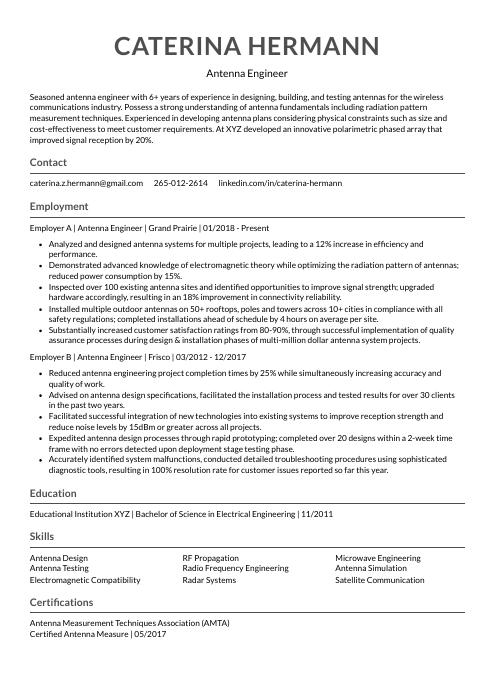 Indri
Indri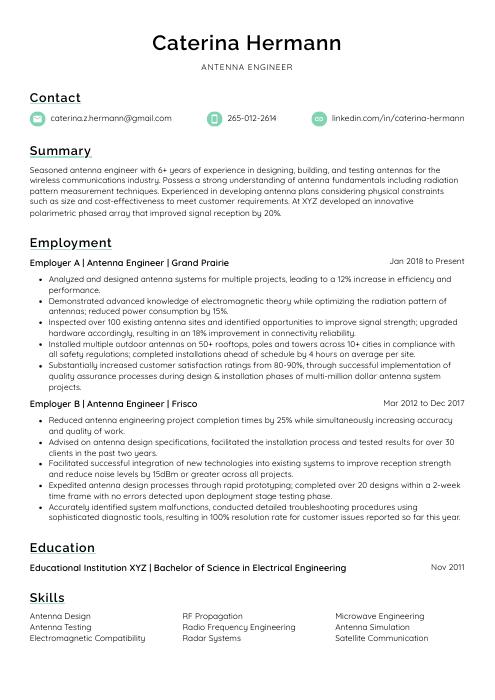 Lorikeet
Lorikeet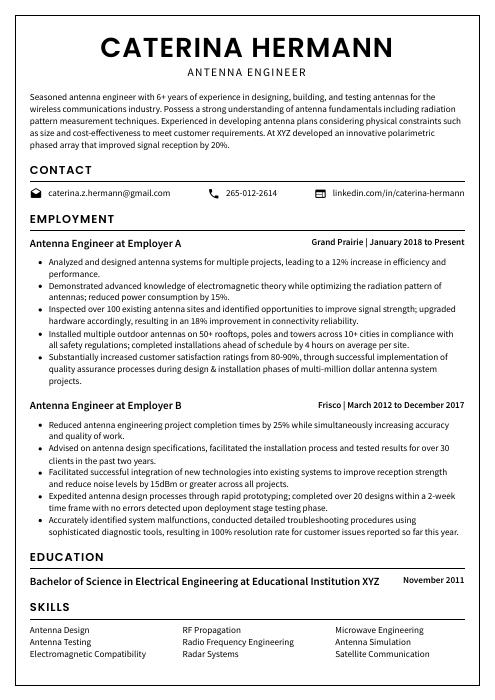 Cormorant
Cormorant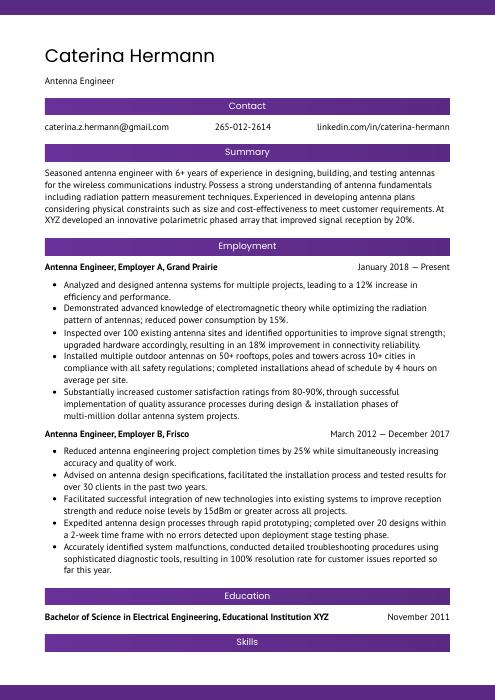 Jerboa
Jerboa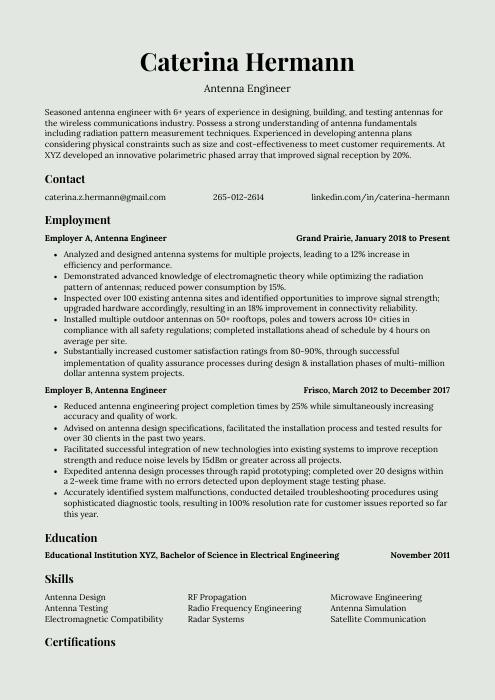 Saola
Saola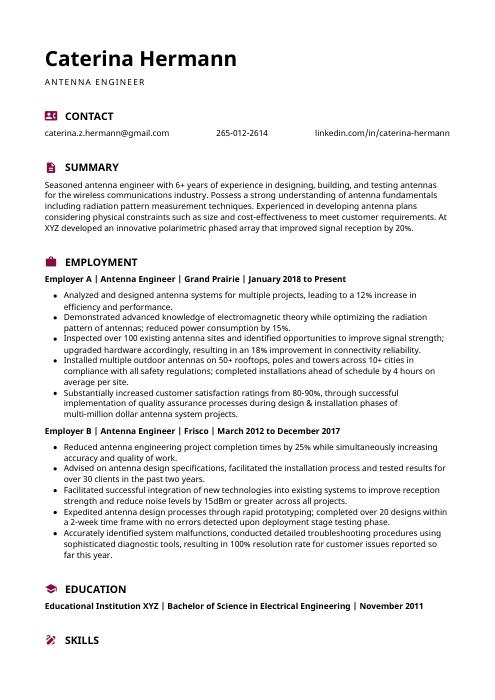 Hoopoe
Hoopoe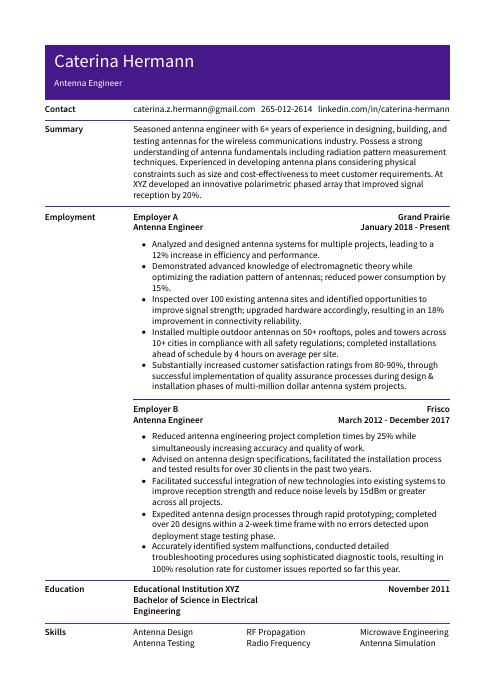 Pika
Pika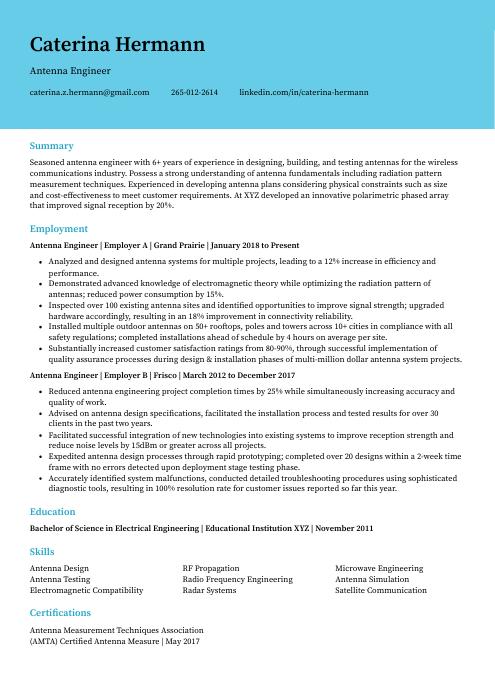 Dugong
Dugong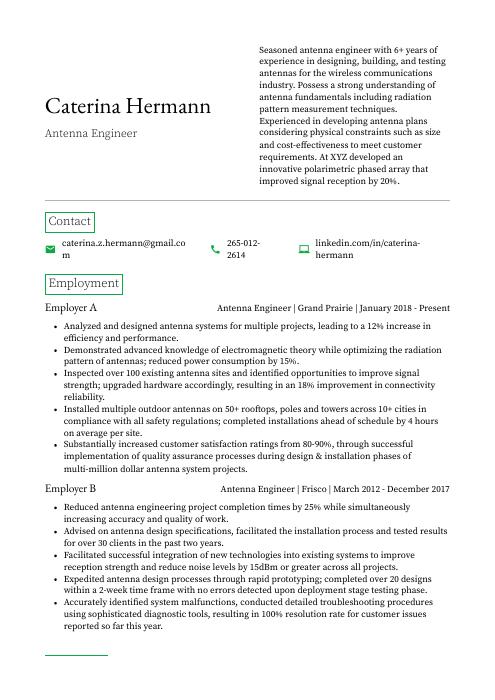 Quokka
Quokka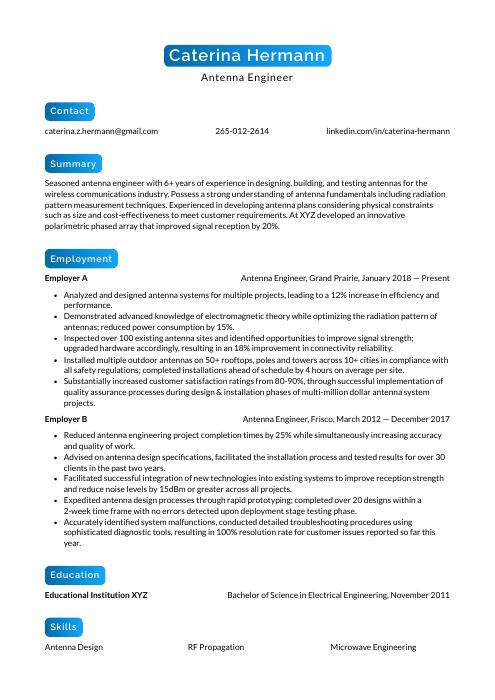 Kinkajou
Kinkajou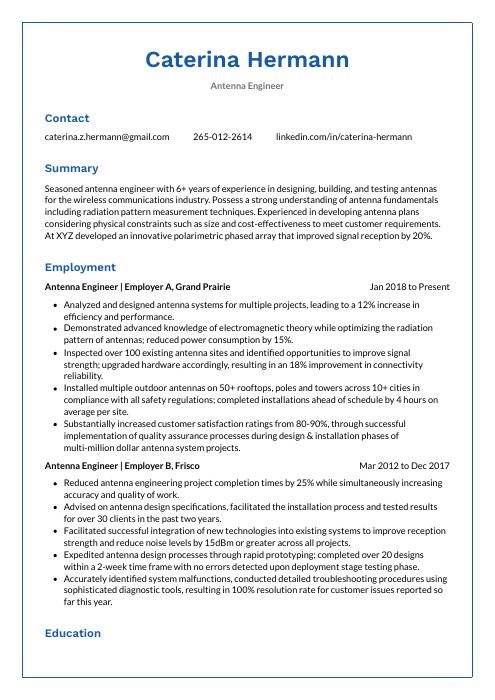 Markhor
Markhor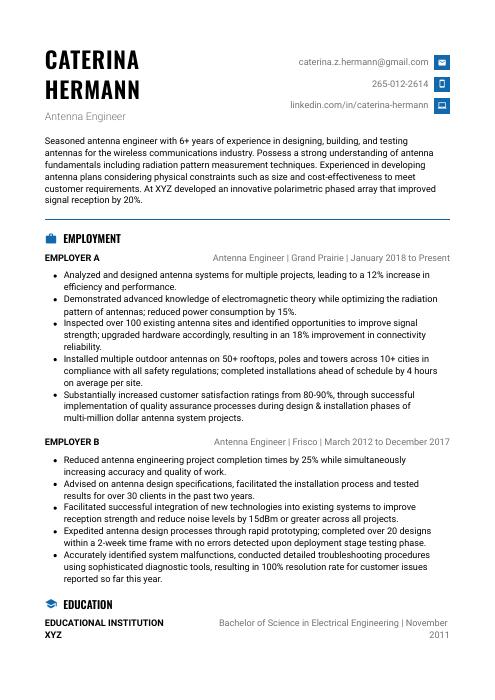 Echidna
Echidna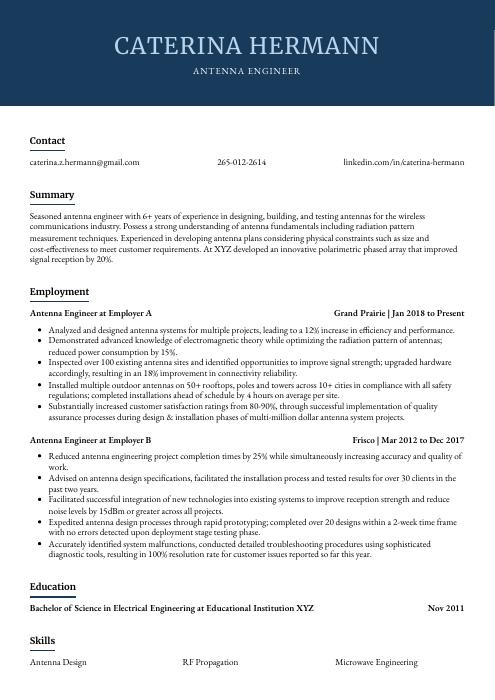 Bonobo
Bonobo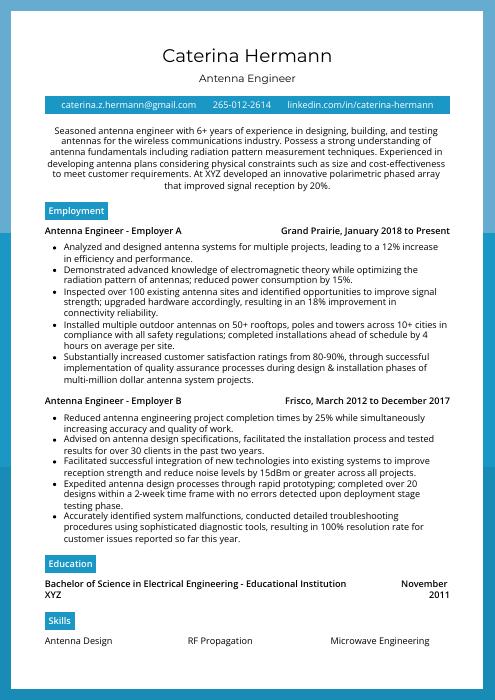 Rhea
Rhea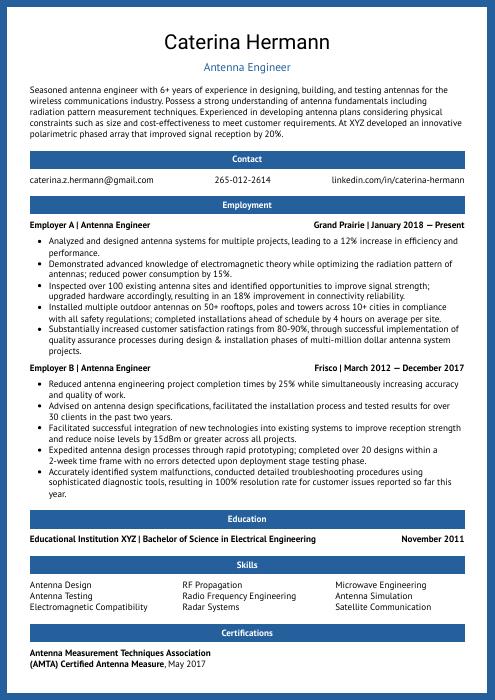 Ocelot
Ocelot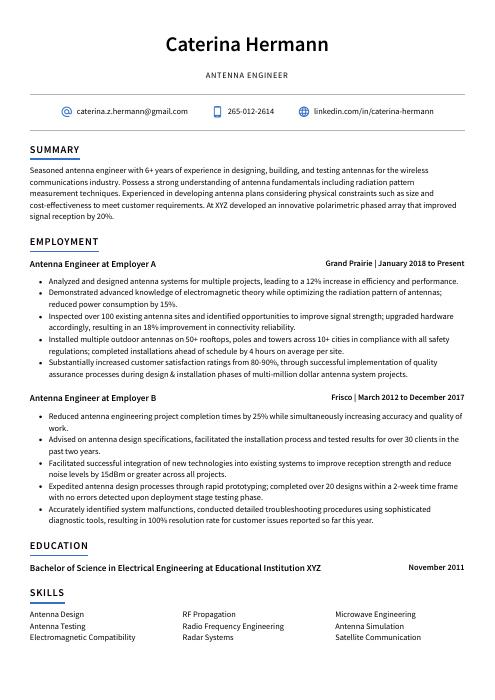 Axolotl
Axolotl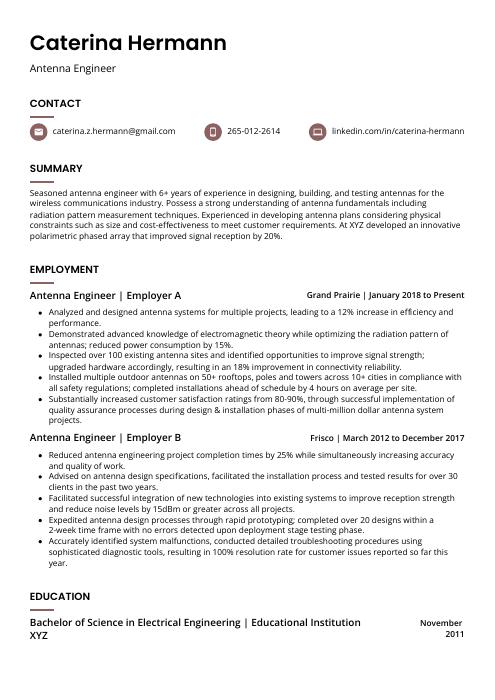 Fossa
Fossa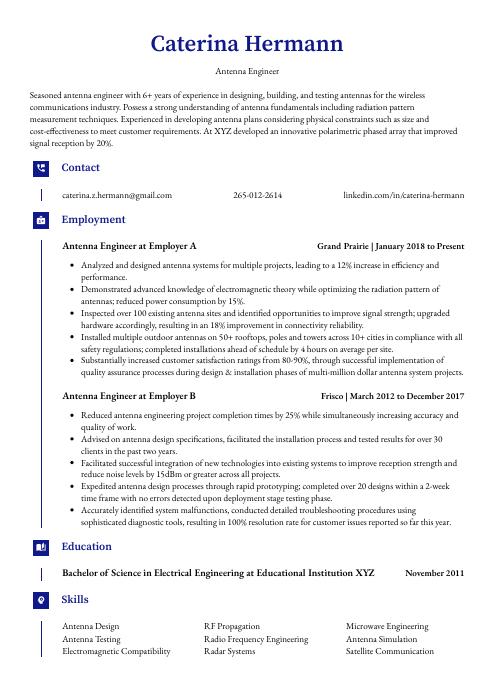 Gharial
Gharial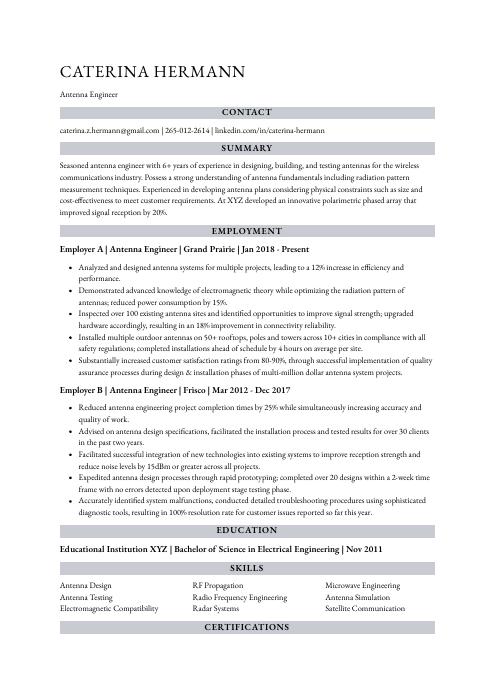 Numbat
Numbat Rezjumei
Rezjumei
